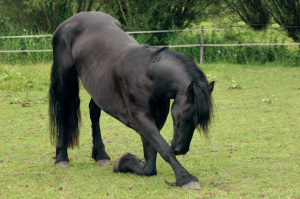 Regardless of what species we’re referring to, whether human, dog, horse, dolphin or bird, when teaching something new, the easier we can make the training session, the better the results. If a dog or a child feels successful, their desire to keep trying will be much greater than if they keep failing. How long will a dog keep trying different ways of touching a box without getting rewarded? How many times will a dolphin try to pivot on his back unsuccessfully, before giving up? Repeated failure will quickly generate feelings of frustration for anyone trying to figure out how to do something new. Most of us are very goal oriented, so it’s easy to push the criteria too fast, too soon. I had the privilege of being at the last ORCA conference in Denton, TX, with Smart Animal Training Systems’ team. In his presentation, Phung Luu, avian expert and trainer, reminded the crowd of animal trainers that we can get better and faster results when applying behavior momentum(or behavioral momentum) to our training. Providing lots of opportunities for the animal to succeed and be rewarded will increase the animal’s motivation and desire to try.
Regardless of what species we’re referring to, whether human, dog, horse, dolphin or bird, when teaching something new, the easier we can make the training session, the better the results. If a dog or a child feels successful, their desire to keep trying will be much greater than if they keep failing. How long will a dog keep trying different ways of touching a box without getting rewarded? How many times will a dolphin try to pivot on his back unsuccessfully, before giving up? Repeated failure will quickly generate feelings of frustration for anyone trying to figure out how to do something new. Most of us are very goal oriented, so it’s easy to push the criteria too fast, too soon. I had the privilege of being at the last ORCA conference in Denton, TX, with Smart Animal Training Systems’ team. In his presentation, Phung Luu, avian expert and trainer, reminded the crowd of animal trainers that we can get better and faster results when applying behavior momentum(or behavioral momentum) to our training. Providing lots of opportunities for the animal to succeed and be rewarded will increase the animal’s motivation and desire to try.
Before we dive into the application of behavior momentum, let’s first understand the concepts involved. In animal training, we can all agree that the more a behavior is rewarded, the more likely it will be repeated. Let’s take an example. If we ask a dog to ‘sit’ and reward her for getting in position 500 times, and we also do the same for ‘down’ but only repeat that sequence 50 times, the likelihood of the dog sitting over lying down when asked will be 10 times greater (with all conditions being the same of course). So the strength of any behavior depends on how often it was rewarded (Matching Law). That behavior will also be more resistant to changes in the environment. If another person walks in the room, the dog is still likely to ‘sit’ when asked, but she may not lie down. That resistance to change is what is referred to as behavior momentum. In that sense, learned behavior can be compared to the physical effects of obstacles or external forces applied to an object in movement (Nevin & al., 1983). If a large boulder comes rolling down a hill at the same time as a small rock, it’s mass and velocity will give it so much momentum that to stop it would require much more force and resistance than to stop the small rock. If we go back to our example, the ‘sit’ could be compared to the boulder and the ‘down’ to the small rock. The mass of the behavior is defined by how much change in the environment it would take to disrupt it. Its velocity is related to its response rate. As I work with service dogs, providing the dog with sufficient repetitions of any behavior becomes critical if I want them to perform under all the different conditions they will be faced with. The ultimate goal also being to transfer the dog to another person who will not have the same tone of voice or body movements, the response to the cue has to be solid enough to be resistant to all those differences.
 Now that we have identified that, based on their reinforcement history, not all behaviors will be equal when it comes to their momentum, we can use this in our training sessions. Let’s imagine that we’re trying to teach a brand new behavior to our dog, like lying down on a mat. For our training session to be successful, our goal should be to keep the dog interested and willing to offer behavior. If we wait for the dog to look at the mat, then place a paw on the mat, then two etc., we will eventually get to our goal. But as we increase our criteria, we also decrease the chances of the dog’s success, especially if we go too fast. ‘The greater the rate of reinforcement, the greater the behavioral momentum’ (Mace & al., 1988). So, if we introduce one or more ‘high probability’ behaviors within our training session immediately before a ‘low-probability’ behavior, we immediately increase our chances to reinforce the dog and create a behavior momentum. In other words, by inserting behaviors that are easy and well-known by the animal when training new behaviors, we can keep our sessions more interesting, thus increasing the motivation of the animal to keep trying.
Now that we have identified that, based on their reinforcement history, not all behaviors will be equal when it comes to their momentum, we can use this in our training sessions. Let’s imagine that we’re trying to teach a brand new behavior to our dog, like lying down on a mat. For our training session to be successful, our goal should be to keep the dog interested and willing to offer behavior. If we wait for the dog to look at the mat, then place a paw on the mat, then two etc., we will eventually get to our goal. But as we increase our criteria, we also decrease the chances of the dog’s success, especially if we go too fast. ‘The greater the rate of reinforcement, the greater the behavioral momentum’ (Mace & al., 1988). So, if we introduce one or more ‘high probability’ behaviors within our training session immediately before a ‘low-probability’ behavior, we immediately increase our chances to reinforce the dog and create a behavior momentum. In other words, by inserting behaviors that are easy and well-known by the animal when training new behaviors, we can keep our sessions more interesting, thus increasing the motivation of the animal to keep trying.
 Research with children has shown that when a child tends to shut down as soon as we make a request and clearly lacks motivation when we try to interact with him, we can use behavior momentum to increase his motivation (Leach, 1900). We can change the dynamics by making easy requests before asking for something that would require more effort. By applying a pattern of requests such as easy-easy-easy-hard-easy-easy-hard, etc., we help the child feel more successful and therefore more motivated to comply. Success leads to confidence, fun and ultimately to the desire to repeat the task we feel good at. Most of us chose a career that we feel we can be master based on our history of success with similar tasks. With animals the same dynamic applies. If we were training grizzly bears as opposed to dogs, we certainly wouldn’t want to get them frustrated or angry. Using behavior momentum allows for reduced frustration, reduced aggression, increased compliance and is certainly a safer alternative when working with dangerous animals.
Research with children has shown that when a child tends to shut down as soon as we make a request and clearly lacks motivation when we try to interact with him, we can use behavior momentum to increase his motivation (Leach, 1900). We can change the dynamics by making easy requests before asking for something that would require more effort. By applying a pattern of requests such as easy-easy-easy-hard-easy-easy-hard, etc., we help the child feel more successful and therefore more motivated to comply. Success leads to confidence, fun and ultimately to the desire to repeat the task we feel good at. Most of us chose a career that we feel we can be master based on our history of success with similar tasks. With animals the same dynamic applies. If we were training grizzly bears as opposed to dogs, we certainly wouldn’t want to get them frustrated or angry. Using behavior momentum allows for reduced frustration, reduced aggression, increased compliance and is certainly a safer alternative when working with dangerous animals.
So are there possible pitfalls? When using multiple behaviors, the risk is always to end up with a chain of behaviors. When teaching a new behavior, like ‘down’, if we always ask for ‘touch’, then ‘down’, using ‘touch’ as the high-probability behavior, we’re very likely to teach the dog to offer ‘touch-down’ as a sequence of behaviors. It’s therefore important to have more than one high-probability behavior and change the sequence up.
A successful training session is motivating and fun to the animal. The concept of behavior momentum allows for a better understanding of the effects of reinforcement history on behavior. It also offers an additional tool when teaching new behaviors. Behavior momentum can also be applied anytime we need to strengthen a weak behavior, or when the dog is distracted.
Jennifer Cattet Ph.D.
Related articles





In a discussion with Dr. Cattet she made the point that this is NOT Premack. In Premack the high probability behavior comes AFTER the low probability behavior(eat your broccoli and you get ice cream). In behavioral momentum the high probability behavior(s) happen before the low probability behavior. It is also important that the time between behaviors is short, so rate of reinforcement is increased.
Perhaps a minor point to mention is that these are not hard rules, and her focus here is on the concept. So in going from 50 to 500 repetitions, it’s not really 50 times greater. The Matching Law curve is not often linear, and there may be marked deviations at the start (communication errors, etc.) and at the end (behavioral noise limits).
And while the focus here is on high rates and repetitions (as Wes mentioned as important), once sufficient persistence has been achieved other work indicates subsequent reinforcement delays and omissions can then result in further resistance to extinction (Schedules of Positive Reinforcement). So that the Behavior Momentum concept is very useful, but not the entire story.
On that note any calm training sessions must later be repeated with a variety of distractions and locations. Many people first find this out at the dog park when he won’t listen, even after 100’s of repetitions elsewhere. The same applies to slight variations in the training pattern. I’ve also seen people become very frustrated from initially failing to hold a distinct training pattern, where they do too much varied talking and moving while trying to teach and the dog doesn’t have a clear pattern to follow.
And behavioral momentum or persistence also applies to nasty habits that your dogs insists on doing, making it more difficult than you might have expected to change the behavior.
Interesting.
I never thought of this training/teaching method as a pertaining to a ‘law’ (rule, etc) so much as common sense.
As my Mother taught me, “Nothing succeeds like success” — so in any learning session the successes should outnumer the misses.